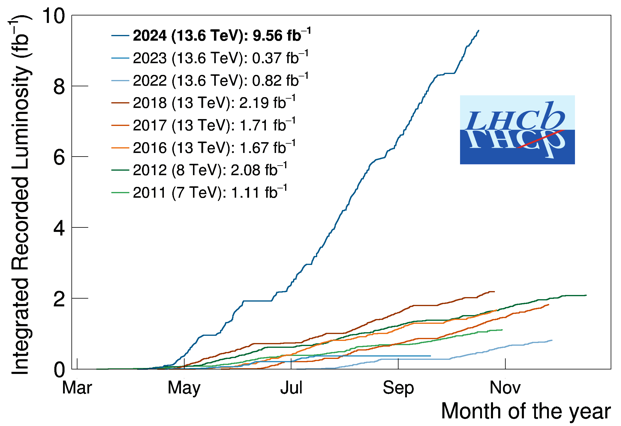The 2024 proton-proton collision period at the LHC ended this week. This period was particularly successful for LHCb, also owing to the excellent performance of the LHC. The rate at which the experiment was able to acquire integrated luminosity was spectacularly higher than in previous years, as shown in the luminosity plots presented in this page. LHCb has largely exceeded its target of an integrated luminosity of 9 fb-1, which is higher than the sum of luminosities from Run 1 and Run 2. LHCb operated at a record instantaneous luminosity of 2×1033cm-2s-1, corresponding to μ=5.3, the average number of visible pp collisions per bunch crossing. Not only did LHCb accumulate a record amount of data, but the efficiency of beauty and charm particle selection for hadronic channels has increased by a factor between 2 and 3 compared to previous years, due to an upgraded trigger design. LHCb also collected this year ten times more data from proton collisions with gases injected into the LHC beam pipe measured simultaneously with pp collisions.
This success was achieved following the installation and subsequent commissioning of the upgraded LHCb detector during LS2. Most of the sub-detectors were replaced or upgraded to cope with the much more demanding data-taking conditions. The front-end electronics of all the sub-detectors have been modified, and the detector largely rebuilt, using the latest technological developments. The VErtex LOcator (VELO) has been replaced by a new silicon pixel detector that comes as close as 5.1 mm to the proton beams. The tracking detectors have been replaced by two brand new detectors. In the section upstream of the magnet there is a new high-granularity silicon micro-strip detector, the Upstream Tracker (UT). In the section downstream of the magnet, three Scintillating Fibre Tracker (SciFi) stations have been installed, consisting of 2.5m-long scintillating plastic fibres read out by silicon photo-multipliers. RICH1 is now a completely new detector: the optics and mechanics have been re-designed and re-built, the mirrors have a larger radius of curvature, and Hybrid Photon Detectors have been replaced by multianode photomultipliers in both RICH1 and RICH2 detectors. The Scintillating Pad Detector (SPD), the Preshower (PS) and the first Muon chamber (M1) were removed. Using multiple detectors, PLUME, BCM and RMS, LHCb measures the collision rate and shape of the luminous region in real time, allowing the LHC to ensure a constant luminosity for the collisions in LHCb. In addition, the SMOG2 system has been installed, which allows the injection of gases including hydrogen, oxygen, deuterium, nitrogen, and a range of noble gases into a storage cell just upstream of the LHCb collision region, allowing the study of the collisions of LHC protons with these gases in a fixed-target mode.
In the LHC, bunches of protons cross every 25 ns, corresponding to a frequency of 40 MHz (with about 30 MHz of events involving collisions at the LHCb interaction point). During Run 1 and Run 2 the event rate was filtered down to 1 MHz using fast electronics and comparatively simple algorithms to select the most interesting events. These events were then processed in a dedicated computer farm, located underground close to the detector; this allowed additional, more sophisticated selection criteria to be applied using software (see the 14 October 2015 news for more details). For Run 3 and beyond, this has changed radically: the hardware-based trigger has been removed and the entire detector is read out at the full rate of 40 MHz. The data from the detector are transferred to a completely new data centre at the surface, where events are assembled at the unprecedented bandwidth of 40 Tb/s. This allows all the event selections to be done in software, with a first layer based on Graphics Processing Units (GPUs), then followed by more sophisticated algorithms executed in the upgraded computer farm. This concept, called Real Time Analysis, has been pioneered by LHCb, allowing for a more precise, flexible and efficient data filtering. Overall, nearly 40 PB of data were recorded and distributed for final processing to more than 20 computing centres of the Worldwide LHC Computing Grid (WLCG), thanks to the efforts of all the physicists and computing engineers from the experiment and affiliated computing sites.


